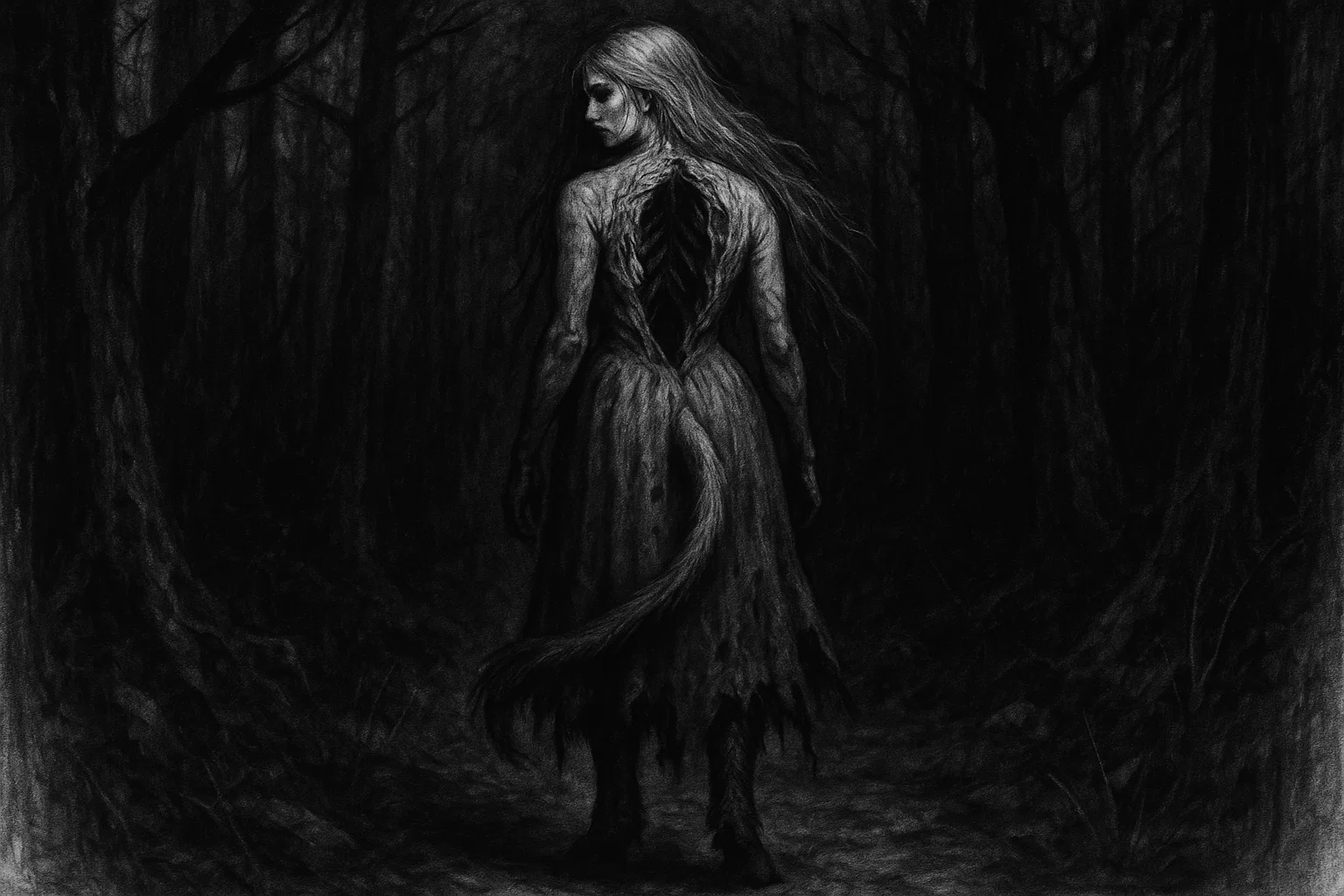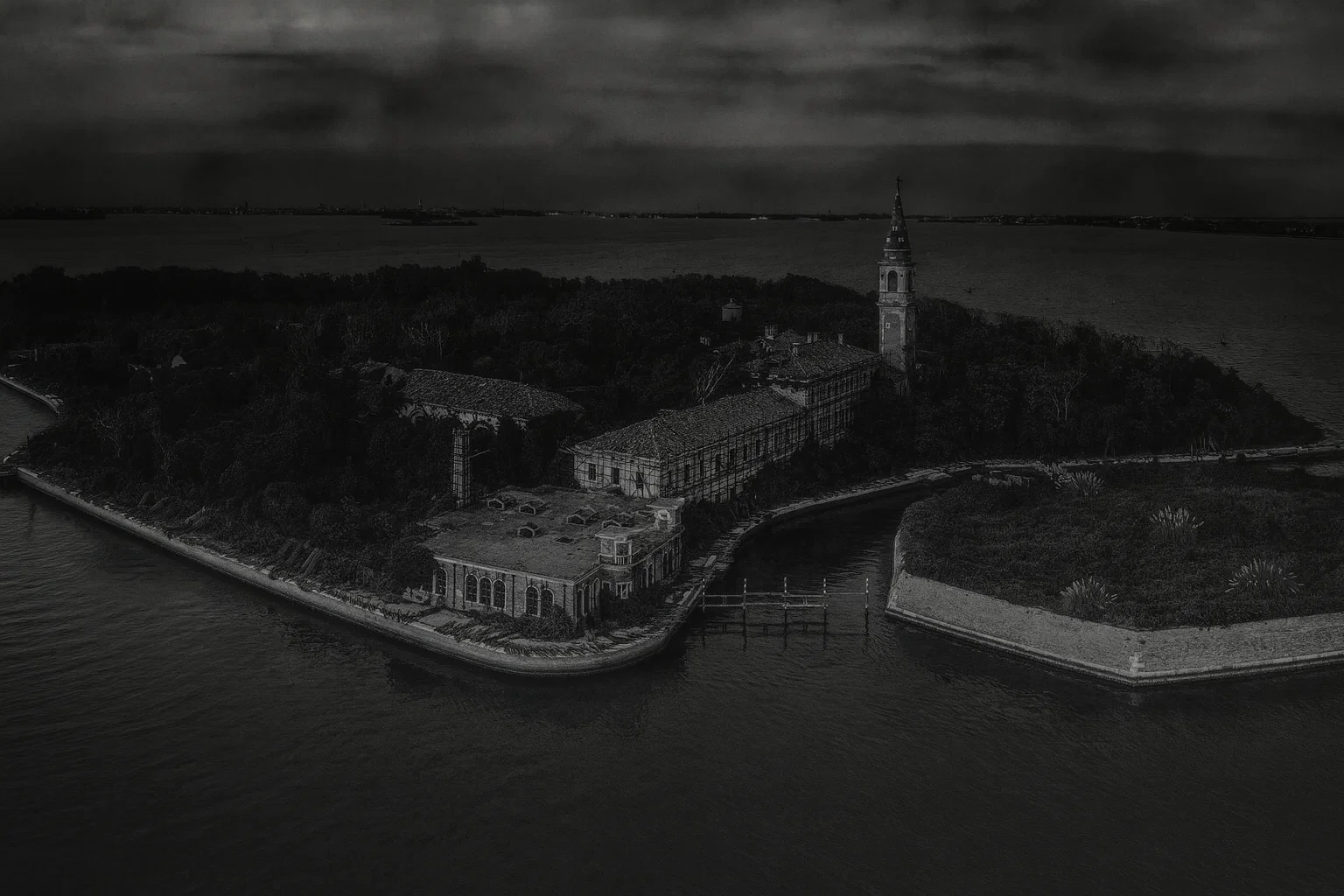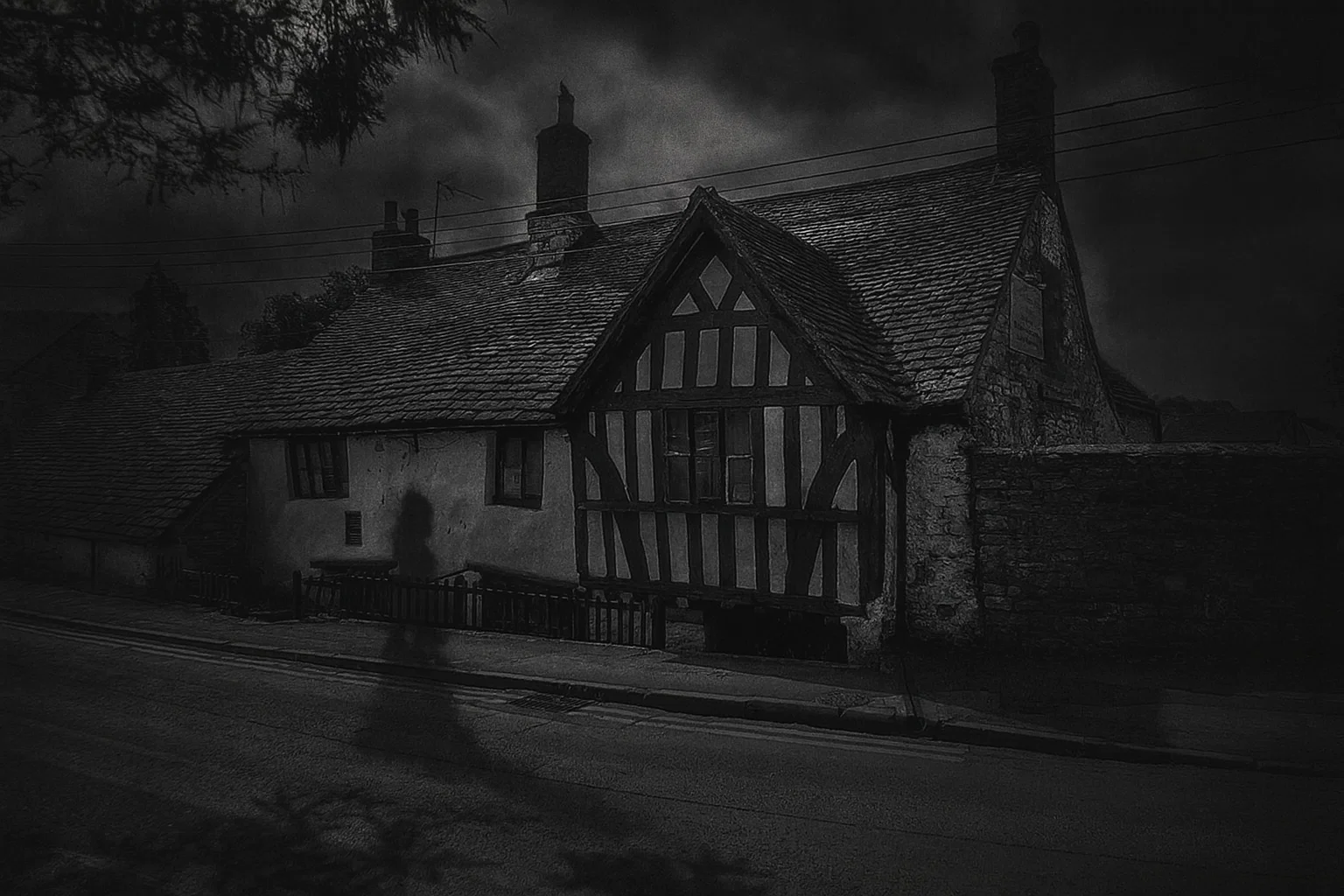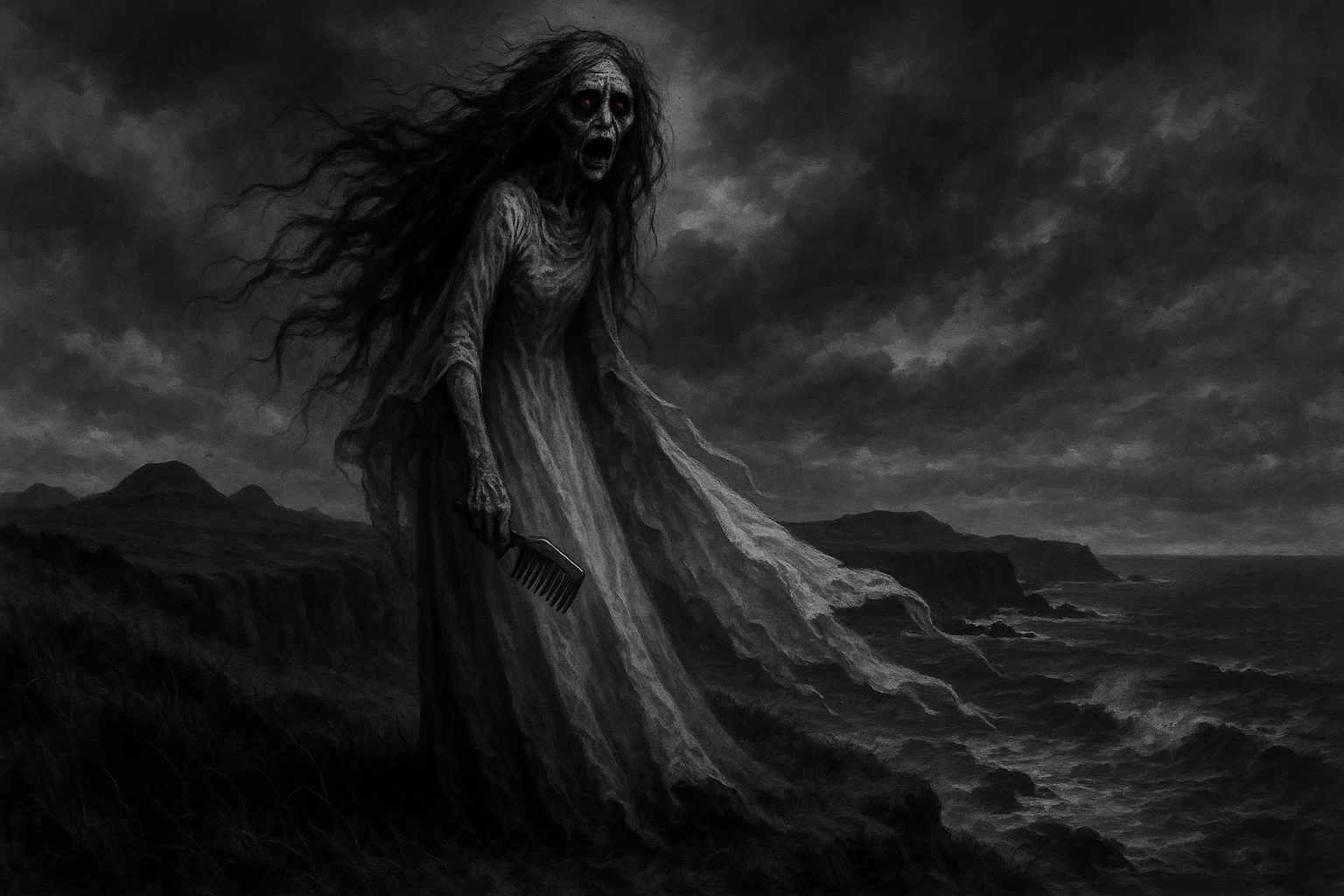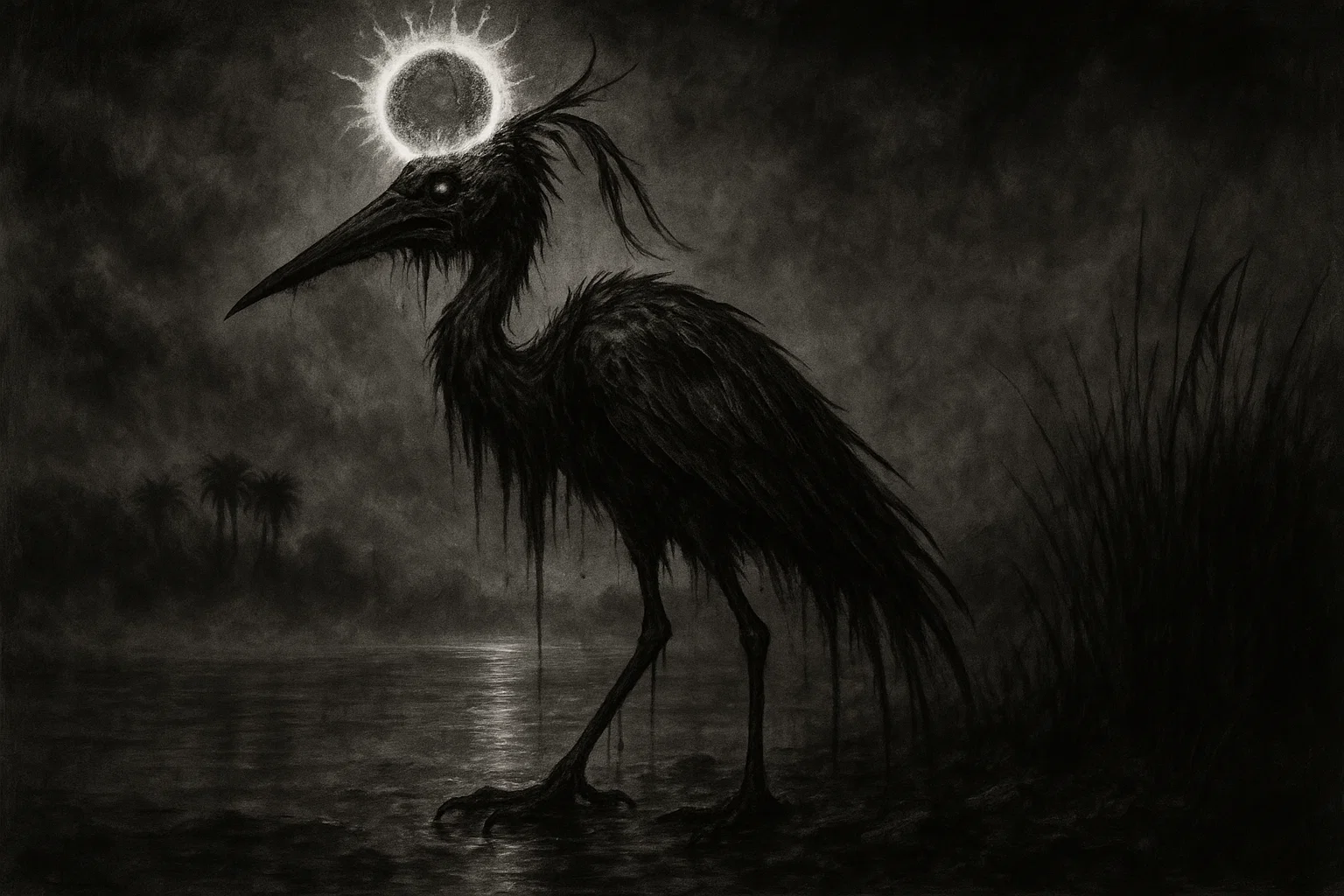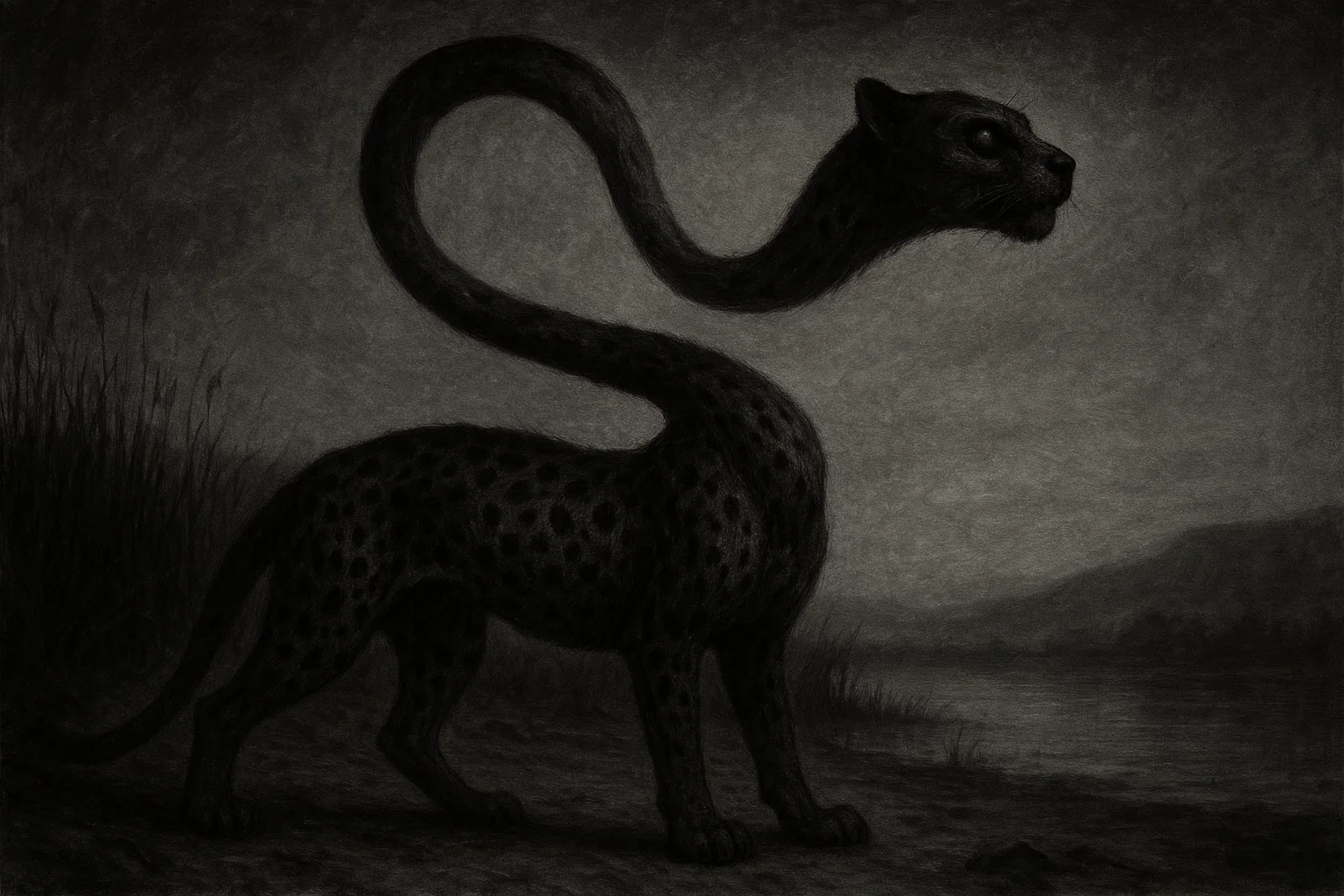The Huldra is a powerful monster in Scandinavian folklore, a seductive forest creature who represents both temptation and peril.
Often depicted as a stunning young woman with long flowing hair and pale skin, she lures wanderers deeper into the woods with her enchanting beauty and melodic voice. Yet beneath her charm lies a hidden truth: a cow’s tail or fox’s brush peeking from her skirts, and a back hollow like a decayed tree trunk.
Summary
Key Takeaways
| Attribute | Details |
|---|---|
| Names | Huldra, Hulder, Skogsrå; Norwegian for “the hidden one,” Swedish for “forest spirit” |
| Nature | Supernatural forest spirit or elf-like being |
| Species | Humanoid |
| Appearance | Beautiful young woman from the front with long hair and fair skin; cow or fox tail, hollow tree-like back from behind |
| Area | Scandinavia, especially Norway and Sweden; forests, mountains, and underground realms |
| Creation | Part of the Huldrefolk race, possibly descendants of Adam and Eve’s unwashed children or pagan nature guardians |
| Weaknesses | Christian marriage causes tail to fall off; religious artifacts, refusing gifts, seeing her true form |
| First Known | Medieval folklore collections, around 16th century in Norwegian tales |
| Myth Origin | Pre-Christian Scandinavian paganism, influenced by Germanic figures like Holda |
| Strengths | Superhuman strength, shape-shifting, enchanting songs |
| Habitat | Deep forests, mountain caves with hidden entrances |
| Diet | Not specified; focuses on seduction rather than consumption |
Who or What Is a Huldra?
The Huldra is a female forest spirit famous for her irresistible beauty and deceptive nature. She appears as a lithe, fair-haired maiden dressed in simple peasant clothes, her eyes sparkling with an unnatural gleam that draws men like moths to flame.
This enchanting facade hides her true form, revealed only from behind: a tail swishing like that of a grazing cow and a spine curved inward like bark peeled from an ancient oak.
As a member of the Huldrefolk, she patrols the wild edges where human settlements fade into untamed woodland, acting as both protector and predator of the natural order.
In Norwegian folklore, the Huldra often targets lone woodsmen or shepherds, inviting them to dance in moonlit clearings or to share a fleeting romance that blurs the line between dream and reality.
Her interactions carry weighty consequences, for she blesses the respectful with bountiful hunts and fertile fields but curses the rude with barren lands or wandering minds.
Male counterparts, known as huldrekall, appear far less often and lack her grace, instead resembling grotesque trolls.
Ever Walk Into a Room and Instantly Feel Something Watching You?
Millions have used burning sage to force out unwanted energies and ghosts. This concentrated White Sage & Palo Santo spray does the same job in seconds – just a few spritzes instantly lifts stagnation, breaks attachments, and restores peace most people feel immediately.
Etymology
The name Huldra traces its roots to Old Norse and Proto-Germanic languages, where it originates from the word huld, meaning “hidden,” “secret,” or “covered.”
In Norwegian folklore, the term evolves into huldra, the definite feminine form, meaning “the hidden one.” At the same time, the indefinite hulder refers to any such being. The plural huldrer or huldrene denotes the broader Huldrefolk race, emphasizing her place within a secretive underground society.
In Swedish lore, she becomes skogsrå, literally “forest warden” or “wood sprite,” from skog for woods and rå for guardian spirit. This term highlights her role in overseeing sylvan realms.
Another Swedish variant, Tallemaja, translates to “pine tree Mary,” blending Christian influences with pagan roots to evoke a maternal figure tied to evergreens. Among the Sámi people of northern Scandinavia, she appears as Ulda, a term possibly linked to earth-dwelling entities, highlighting indigenous ties to the landscape.
Scholars connect Huldra to Germanic figures, such as Holda or Frau Holle (a benevolent yet fearsome goddess of winter and witchcraft mentioned in 13th-century texts, such as the Völsunga Saga).
During the Christianization of Scandinavia in the 8th to 11th centuries, these names merged, transforming pagan deities into demonic temptresses.
By the 19th century, folklorists like Peter Christen Asbjørnsen documented these shifts in collections such as Norske Folkeeventyr, where phonetic drifts—like huldre to huldrin in dialects—added layers of local flavor.
You May Also Like: Koschei the Deathless: The Skeleton Sorcerer Who Couldn’t Die
What Does the Huldra Look Like?
Across Scandinavian sources, the Huldra presents a striking contrast in her appearance, designed to beguile from one angle and horrify from another.
From the front, she resembles an idealized young woman of the rural north: tall and slender with porcelain skin, golden or chestnut hair cascading to her waist, and eyes of piercing blue or green that hold a hypnotic depth.
Her clothes mirror those of a simple farm girl—a flowing white dress or apron that sways with her graceful movements—often barefoot, blending seamlessly with the forest floor.
Turn her around, however, and the illusion shatters. Protruding from beneath her hem is a long, swishing tail akin to a cow’s. However, some tales describe it as a fox’s bushy brush or even a horse’s flowing mane, always twitching with restless energy.
Her back tells an even grimmer story: hollow and bark-like, resembling the rotted core of a fallen tree, with ribs visible through papery skin stretched taut over emptiness.
Mythology
The Huldra’s mythology weaves through pre-Christian Scandinavian paganism, where she serves as a rå—a warden spirit bound to specific natural domains, such as forests and hills.
Early roots likely tie her to fertility goddesses and earth mothers, guardians who ensured bountiful harvests in exchange for human reverence.
As Christianity spread from the 8th century onward, these benevolent aspects darkened; church teachings recast her as a demonic seductress, akin to Eve’s unwashed offspring hidden from God in shame. This shift appears in medieval sermons warning against woodland temptations, blending old Norse reverence for landvættir (land spirits) with biblical motifs of fallen angels.
Her earliest documented appearances appear in 16th- and 17th-century Norwegian folk collections, such as those compiled by clergymen like Hans Lauritzen, who recorded oral tales of Huldrefolk as troll-like underground dwellers.
By the 19th century, scholars Peter Christen Asbjørnsen and Jørgen Moe formalized her in Norske Folkeeventyr (1842–1852), drawing from rural storytellers in Telemark and Hardanger.
Swedish variants, as skogsrå, surface in 18th-century gazetteers like those of Abraham Mamreov, linking her to skogsvættir (forest wights). Germanic influences, as seen in Holda in the Schwäbische Kindermärchen (1854), suggest cross-pollination during Viking migrations.
Post-Christian lore portrays Odin leading the Wild Hunt against her kin, storms ravaging their forest homes as divine retribution.
Today, her myths persist in place names like Huldrehaugen (Huldra’s Mound) across Norway, marking sites of ancient encounters.
Legends
The Woodsman’s Broken Vow
Once upon a time, there was a young logger named Einar who wandered deep into the beautiful Norwegian forest one cool autumn evening. He carried his heavy axe on his shoulder as the sun began to set, turning the leaves into a brilliant gold. The air around him was filled with a soft, enchanting sound that tugged gently at his heart, as if it were a magical song.
In a sunlit clearing, Einar saw a maiden whose beauty took his breath away. Her hair glimmered like sunlight, her dress was as white as fresh snow, and her laughter floated through the air like tinkling wind chimes. She waved to him, inviting him closer, and said with a sweet voice, “Come, weary traveler, dance with me and forget about your hard work.”
Mesmerized, Einar took her hand, and together they danced in the clearing, as if fiddles were playing somewhere nearby. Hours slipped away in a joyful blur, her presence warm and comforting. As stars twinkled above them, she leaned in and softly whispered, “Promise me you won’t tell anyone about this night, or the forest will take you forever.”
Einar, enchanted and eager, nodded and sealed his promise with a kiss. But as the sun rose, the maiden disappeared like mist, leaving him both dazed and filled with unforgettable memories.
Back in his village, as Einar’s friends eagerly asked about his adventures in the woods, he couldn’t help but share the story of the breathtaking maiden.
But as soon as he spoke, a wild wind howled through the village, tearing apart crops and breaking old barns. Suddenly, his fields dried up, his animals became ill, and dark shadows seemed to follow him.
You May Also Like: Baba Yaga: Iron-Toothed Witch of Slavic Folklore
The Blacksmith’s Union
In the stunning shadow of Sweden’s rugged mountains, a blacksmith named Lars worked hard at his forge during the day and dreamed of love and companionship at night. He was a big, strong man, living alone with his forge as the only light in the quiet valley.
One stormy evening, as thunder boomed in the sky, a knock on his door interrupted his solitude. When he opened it, he found a woman standing there, soaked from the rain, yet untouched by it. Her eyes sparkled like emeralds, and her outfit was made of green leaves that hugged her form.
“You work alone in the dark,” she said, her voice warm and inviting. “May I warm myself by your fire?”
Lars was speechless, mesmerized by her beauty, but he welcomed her inside. She moved gracefully, tending to his fire as if she had always belonged there. As the days turned into weeks, they grew closer, sharing conversations and meals together.
When the moon was full, Lars proposed, promising to love and care for her forever. She accepted, her smile shining like the stars above.
Their wedding day was bright and joyful in the village church, filled with the scents of flowers and incense. But when the bride stepped forward, a gasp echoed through the crowd as a long, coarse tail slipped from beneath her dress, curling up like a snake before turning to dust.
The woman turned pale but then regained her composure, standing taller as if a heavy burden had been lifted. “I am free at last,” she whispered to Lars, who held her hand firmly without any fear.
Together, they built a happy life filled with warmth: Lars’s forge was always busy, and their home was filled with children as strong as oak trees. But one day, after a disagreement, Lars raised his hand in anger.
In response, she grabbed a red-hot iron poker from the fire. With her bare hands, she twisted it into a shape, her voice firm: “Remember, husband, I have a wild spirit.” From that day onward, peace and understanding guided their lives, showing how important respect is in a relationship.
The Shepherd’s Mountain Lure
In the beautiful fjords of northern Norway, influenced by Sami culture, a young shepherd named Finn looked after his sheep during the summer. One sunny afternoon, while he was resting against a large rock, a girl with golden hair and a crown of wildflowers approached him, her laughter bright and cheerful.
“You have a lost sheep,” she playfully said, pointing to a ewe wandering too close to the edge of a cliff. “Follow me, and I’ll show you the right way.”
Captivated by her charm, Finn got up and followed her along narrow paths that his goats wouldn’t dare to take. She led him to a cave covered in ivy, with an entrance that buzzed with hidden energy.
Inside, torches lit up, revealing sparkling halls filled with tables brimming with berries and mead. Elves and magical beings were dancing, creating a rainbow of colors in the air, with the girl at the center of it all.
“Stay with us,” she encouraged, offering him a goblet. “Drink this and experience endless joy.” Finn took a sip, feeling the sweetness spread through him, and soon joined in the festivities, losing track of time.
But as the first light of dawn broke through, the girl urged him, “Promise to stay with me here among my friends, and we can enjoy this forever.”
Torn between his world and hers, Finn hesitated but ultimately ran from the cave as voices called after him. The entrance sealed shut behind him, and the furious mountains unleashed avalanches, burying his pastures and hiding the pathways home.
Years later, Finn returned as a weary traveler, whispering his regrets to the wind, forever haunted by memories of that enchanting girl and the joy he had lost in his dreams.
You May Also Like: Jormungandr: The Midgard Serpent Destined to End the Gods
Huldra vs Other Monsters
| Monster Name | Origin | Key Traits | Weaknesses |
|---|---|---|---|
| Huldra | Scandinavia | Seductive beauty, tail and hollow back, forest guardian | Christian marriage, refusing gifts, religious symbols |
| Succubus | Medieval Europe | Shapeshifting demoness, drains life via seduction | Iron, salt, religious invocations |
| Nymph | Greek mythology | Water or tree spirit, eternal youth, alluring dancers | Bound to their domain, human love causes fading |
| Siren | Greek mythology | Bird-women singers, lure sailors to doom | Wax earplugs, avoiding songs |
| Banshee | Irish folklore | Wailing harbinger of death, spectral washerwoman | Iron, can’t cross running water |
| Selkie | Scottish/Orkney | Seal-folk who shed skins for human form, sea lovers | Returning sealskin forces return to sea |
| Rusalka | Slavic folklore | Drowned maiden spirit, drowns men with beauty | Prayers, silver chains |
| Leanan Sidhe | Irish Celtic | Muse fairy, inspires artists to madness via love | Artistic denial, iron weapons |
| Vila | Slavic folklore | Wind spirit dancer, shape-shifts to enchant | Sweet words, avoiding dances |
| Mormo | Greek/Roman | Child-devouring demoness, shapeshifts to tempt | Garlic, protective amulets |
| Lamia | Greek mythology | Serpent-woman, seduces and consumes children | Herbs like rue, divine intervention |
The Huldra shares striking parallels with seductive female spirits across global folklore, particularly in her use of beauty as a trap and ties to natural realms.
Like the succubus or rusalka, she employs enchantment to ensnare men, often leading to madness or loss rather than outright death, emphasizing psychological peril over physical.
Her shapeshifting and domain guardianship align with those of nymphs and vilas, portraying her as an ambivalent force—nurturing for the worthy, vengeful toward despoilers.
Yet differences appear in her transformation potential: unlike the selkie’s reversible skin-shedding or the banshee’s mournful isolation, the Huldra’s Christian redemption arc reflects Scandinavia’s religious evolution, turning pagan peril into salvific union.
Compared to bloodthirsty lamia or mormo, her threats feel more cautionary, rooted in fidelity and environmental respect.
Powers and Abilities
The Huldra wields a suite of abilities deeply intertwined with her forest domain, allowing her to manipulate perceptions and enforce nature’s laws with subtle yet overwhelming force.
Her primary power lies in enchantment, where songs and gazes weave illusions that bend reality, turning wary travelers into willing captives. Superhuman strength manifests in feats like uprooting trees or bending hot iron, reminders of her untamed origins.
As a shapeshifter, she alters her form to mimic lost loved ones or woodland animals, evading detection as she pursues her aims. Blessings and curses flow from her whims: respectful suitors gain prosperous hunts. At the same time, betrayers suffer crop failures or eternal disorientation in the woods.
Huldra’s powers and abilities include:
- Enchanting Song: Melodic voice that hypnotizes listeners, compelling them to follow or dance endlessly.
- Illusory Beauty: Projects a flawless human appearance to conceal the tail and hollow back, fostering trust.
- Superhuman Strength: Capable of lifting full-grown trees or twisting molten metal bare-handed.
- Shapeshifting: Assumes forms of animals (fox, cow) or humans to stalk or seduce prey.
- Nature Curses: Inflicts barren fields, lost paths, or madness on oath-breakers or despoilers.
- Nature Blessings: Grants bountiful harvests, skilled craftsmanship, or safe passage to the respectful.
- Sensory Lure: Emits distant laughter or calls that mimic loved ones, drawing wanderers off trails.
You May Also Like: Sleipnir: The Terrifying Eight-Legged Horse of Norse Mythology
Can You Defeat a Huldra?
Warding off or overcoming a Huldra demands caution and adherence to folklore’s tested safeguards, as direct confrontation often invites greater peril.
The most reliable method involves glimpsing her true form—by maneuvering behind her during an encounter or using mirrors to reflect her hollow back and tail—shattering the enchantment and prompting her flight.
Refusing any offered gifts—be they food, drink, gold, or jewelry—severs her magical hold, preventing soul-binding oaths that could trap victims in eternal servitude.
Christian elements provide potent defenses in post-pagan tales: entering a church during pursuit causes her tail to wither and fall, stripping her powers and allowing marriage to humanize her fully.
Religious artifacts like crosses, holy water, or recited prayers weaken her illusions, forcing her retreat to the shadows.
Iron tools—axes or horseshoes—repel her, echoing broader fairy weaknesses, while salt scattered at doorways blocks entry to homes. For shepherds or loggers, polite acknowledgment without engagement—such as bowing without eye contact—earns safe passage.
Conclusion
The Huldra endures as a timeless emblem of Scandinavia’s wild heart, her tales threading through centuries to remind us of nature’s dual gifts and perils.
From pagan warden to Christian caution, she mirrors humanity’s evolving dance with the unseen, urging respect for boundaries both literal and moral.

